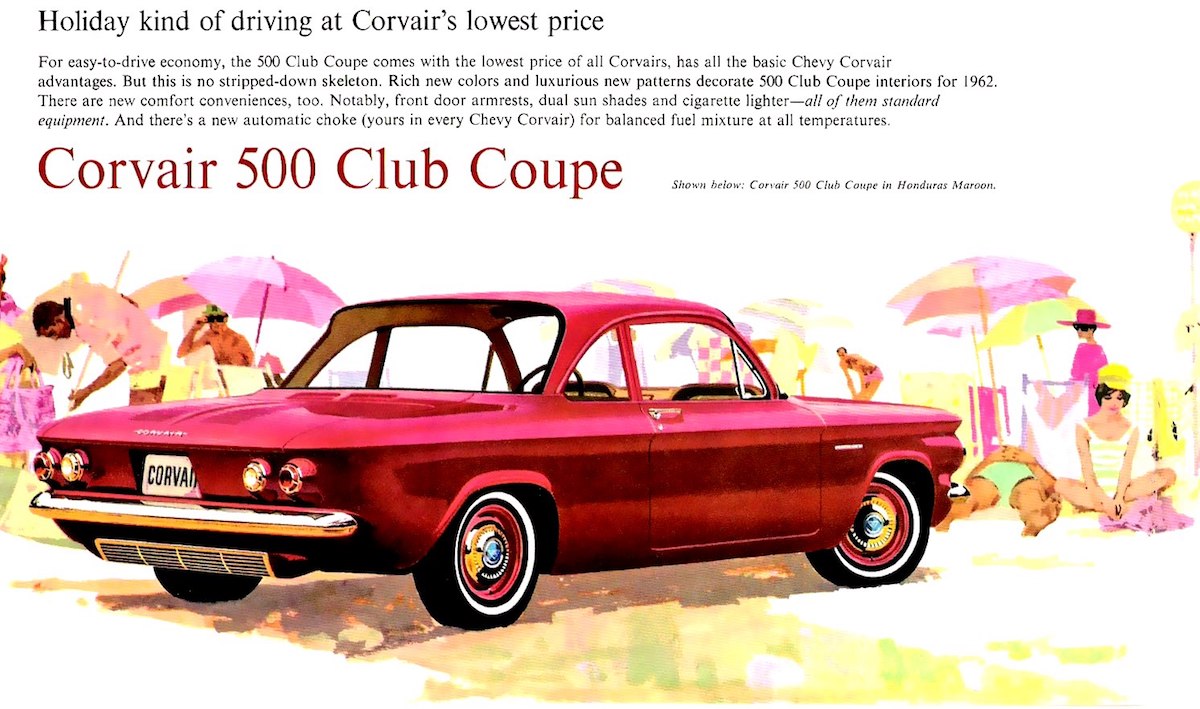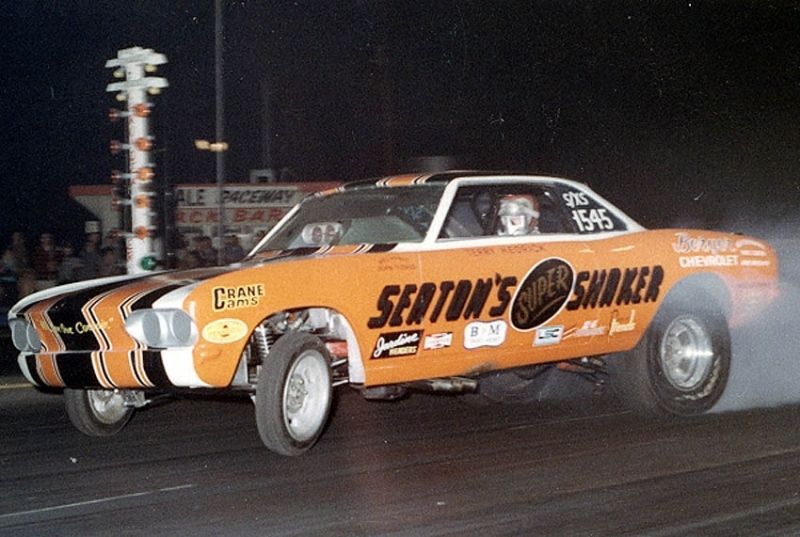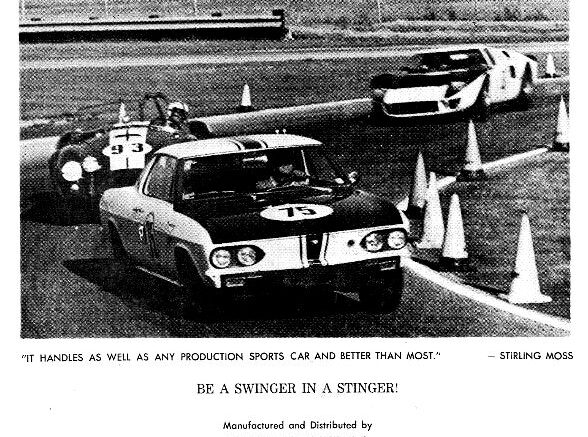Q: Hi Greg and thanks for all your interesting articles on auto nostalgia and collector cars. I’m in my early 60s now, and am wondering about buying a Chevy Corvair so I can go to all the car shows in my area. I would like to know what your opinion of a Corvair is as a collector car, and your remembrance of the car? Thanks very much if you use my letter. Also, the reason I’m thinking of a Corvair is because I see many that are reasonably priced. Alan L., Spokane, Washington.
A: Alan, a very good choice it is and in your case especially because Corvairs don’t demand top dollar for a decent car to get involved in this great hobby. Further, it’s a car that during its production life came under harsh criticism that was actually unfair, but too late to correct a major sales downslide. I’m also going to include my memories of Corvairs on the racetrack, too.
Produced from 1960 to 1969, Corvair had to overcome some early handling concerns and a consumer frenzy that resulted from the book, Unsafe At Any Speed, written by Ralph Nader and published in 1965.

Pictured is an ad for the1962 Corvair. When introduced in 1960 it was Motor Trend Magazine’s Car of the Year. (GM)
In his book, Nader devoted only one chapter to the Corvair, whereas he claimed that due to poor rear suspension design the 1960 to 1963 Corvair was one of the most ill-handling and dangerous cars ever built. Although General Motors had already redesigned the rear suspension in 1954, the book resulted in mass consumer disapproval, much to the dismay of Chevrolet and the General Motors executives.
General Motors then retested several 1960 to 1963 model Corvairs and determined that as long as the owner followed the manufacturer’s recommended tire pressures, 15 pounds in front, 26 pounds in the rear, the car wouldn’t “sway” in the rear and perhaps cause an out of control accident. Sadly a Hollywood star died in a Corvair crash, namely Ernie Kovacs, when he hit a telephone pole during a rainstorm.
With all this said, I do have to give Nader a warranted pat on the back as most of us know that when it comes to checking tire pressures, most people don’t and never will. GM also screwed up trying to discredit Nader by hiring a detective to follow him and find “dirt,” which they never did. GM then lost an invasion of privacy lawsuit brought by Nader, and from that point on Nader was a big star and respected by consumers for exposing cars built in question by putting power and performance ahead of safety. GM paid Nader $425,000, but did not admit any wrongdoing.
So, let’s take a look at Corvair production and sales from 1960 to 1969 – 1960: 253,268; 1961: 337,371; 1962: 336,005; 1963: 288,419; 1964: 214,483; 1965: 247,092; 1966: 109,880; 1967: 27,253; 1968: 15,399; 1969: 6,000.
Unfortunately, after the “Unsafe at Any Speed” book appeared in 1965, and regardless of how much better the Corvair was, sales tumbled drastically. It took a Congressional investigation and a report from the National Highway Safety Administration to stamp Corvair as safe, clearing GM of any wrongdoing.
Sadly, the absolution came three years after the car’s 10-year production run ended in 1969. During all the hearings and popularity of Nader’s book, Corvair sales dropped from a high of 337,371 in 1962 to a low of just 6,000 in 1969. Total Corvair production for its 10-year run was 1,790,316.
Still, a Corvair “written word” irony still exists as Motor Trend magazine named the 1960 Corvair its prestigious “Car of the Year,” so I believe the truth lies somewhere between Nader’s book and the experts at Motor Trend.
Personally I’ve always liked Corvairs in all fashions, from Monza Spyder to the sporty Corsa, and the Corvairs I drove handled well. Although Corvairs may never generate top dollar at a Mecum or Barrett Jackson Auction, collectors with minimum budgets can afford a nice Corvair and are guaranteed interest from show goers nationwide.

The Seaton’s Shaker Corvair funny car was one of the fastest of the day and won many national events. (Seaton collection)
As for power, Corvair’s “flat” air-cooled 6-cylinder engines grew from 140 inches in 1960 to 145 in 1961 through 1963, and finally 164 cubic inches from 1964-69.
Additionally, don’t forget Corvair’s Lakewood Station Wagon or the very neat Greenbrier Sports Wagon passenger van and pickup, both collector favorites.
To further answer your question on values, Corvairs are reasonably priced and an excellent choice for your entry into the world of car collecting. I’ve always appreciated Corvairs because of their unique rear-engine, rear-drive technology. Nice Corvairs sell today from a low of less than $8,000 for a decent four-door sedan to perhaps $18,000 for a restored Spyder Turbo ragtop. The pickups and vans go for over $20,000 easily, and continue to increase in value.
As for racing, Corvairs were once the darling of the nitro Funny Car crowd, as several big names relied on the aerodynamic Corvair design when Funny Cars really looked exactly like their production counterparts.
In my opinion there were two extra special and very fast Corvair funny car teams from 1966 to 1969. The “Seaton’s Shaker” nitro funny car Corvairs owned by GM-connected Pete Seaton was one of the most popular and successful teams. Seaton not surprisingly utilized actual Chevy big block engines that took on the more durable and usually faster Hemi engine teams.
Driven by Terry Hedrick, the Shaker won many AHRA national events and match races going as quick as 7.34 at 194-mph in 1968. Hedrick is also known as the first driver of a Corvair funny car to exceed 200-mph at an AHRA event.
Also sharing top honors in both popularity and quickness from the pen of this writer was the outstanding Doug Thorley “Doug’s Headers” Corvair funny car. Thorley won the 1967 U.S. Nationals with a Chevy powered run of 7.67 seconds at 190-plus. Noted as the first Corvair funny car to go 200-mph was an “unofficial” 200-mph run at NHRA sanctioned Lions Drag Strip in late 1967.
Other drag racers that raced Corvair Funny Cars were Hayden Proffitt, Malcolm Durham, Pisano and Matsubara, “Rapid Ronnie” Runyan, Tom Sturm, Barry “Machine Gun” Kelly, Ken Poffenburger, Dick Bourgeois and Earl Wade, Jim Maybeck, Roger Guzman and Art Ward, and Randy Walls and Gene Altizer.
On the SCCA tracks, where “real” Corvairs raced turning left and right, Don Yenko built special performance Corvairs at his dealership in Canonsburg, Pa. called Yenko Stingers. Based on the Corsa and Monza trims, these Yenko Stingers won the D/Production central region title in 1966 and were available in four stages of dress, specifically 160, 190, 220, and 240 horsepower versions. A total of 185 Stingers were built in 1965 through 1967.
There you have it Alan, a look back at the Chevrolet Corvair, on and off the track. Thanks for you kind words, and good luck if you buy a Corvair.
(Greg Zyla is a syndicated auto columnist who happily accepts reader inquiries or comments on auto nostalgia, collector cars and motorsports at greg@gregzyla.com or snail mail at 303 Roosevelt St., Sayre, Pa. 18840.)



Be the first to comment on "Cars We Remember / Collector Car Corner: Remembering the famous and infamous Chevrolet Corvair, on and off the track"